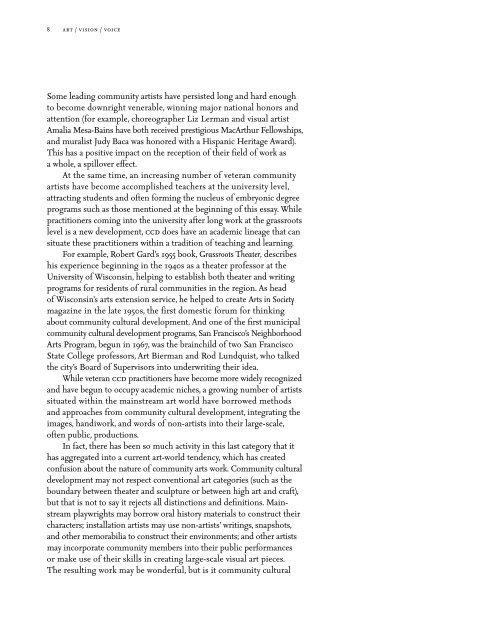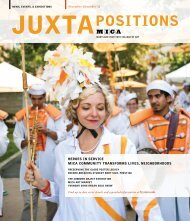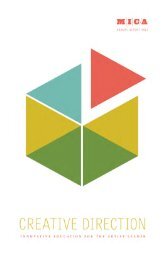art/vision/voice - Maryland Institute College of Art
art/vision/voice - Maryland Institute College of Art
art/vision/voice - Maryland Institute College of Art
Create successful ePaper yourself
Turn your PDF publications into a flip-book with our unique Google optimized e-Paper software.
8 <strong>art</strong> / <strong>vision</strong> / <strong>voice</strong><br />
Some leading community <strong>art</strong>ists have persisted long and hard enough<br />
to become downright venerable, winning major national honors and<br />
attention (for example, choreographer Liz Lerman and visual <strong>art</strong>ist<br />
Amalia Mesa-Bains have both received prestigious Mac<strong>Art</strong>hur Fellowships,<br />
and muralist Judy Baca was honored with a Hispanic Heritage Award).<br />
This has a positive impact on the reception <strong>of</strong> their field <strong>of</strong> work as<br />
a whole, a spillover effect.<br />
At the same time, an increasing number <strong>of</strong> veteran community<br />
<strong>art</strong>ists have become accomplished teachers at the university level,<br />
attracting students and <strong>of</strong>ten forming the nucleus <strong>of</strong> embryonic degree<br />
programs such as those mentioned at the beginning <strong>of</strong> this essay. While<br />
practitioners coming into the university after long work at the grassroots<br />
level is a new development, ccd does have an academic lineage that can<br />
situate these practitioners within a tradition <strong>of</strong> teaching and learning.<br />
For example, Robert Gard’s 1955 book, Grassroots Theater, describes<br />
his experience beginning in the 1940s as a theater pr<strong>of</strong>essor at the<br />
University <strong>of</strong> Wisconsin, helping to establish both theater and writing<br />
programs for residents <strong>of</strong> rural communities in the region. As head<br />
<strong>of</strong> Wisconsin’s <strong>art</strong>s extension service, he helped to create <strong>Art</strong>s in Society<br />
magazine in the late 1950s, the first domestic forum for thinking<br />
about community cultural development. And one <strong>of</strong> the first municipal<br />
community cultural development programs, San Francisco’s Neighborhood<br />
<strong>Art</strong>s Program, begun in 1967, was the brainchild <strong>of</strong> two San Francisco<br />
State <strong>College</strong> pr<strong>of</strong>essors, <strong>Art</strong> Bierman and Rod Lundquist, who talked<br />
the city’s Board <strong>of</strong> Supervisors into underwriting their idea.<br />
While veteran ccd practitioners have become more widely recognized<br />
and have begun to occupy academic niches, a growing number <strong>of</strong> <strong>art</strong>ists<br />
situated within the mainstream <strong>art</strong> world have borrowed methods<br />
and approaches from community cultural development, integrating the<br />
images, handiwork, and words <strong>of</strong> non-<strong>art</strong>ists into their large-scale,<br />
<strong>of</strong>ten public, productions.<br />
In fact, there has been so much activity in this last category that it<br />
has aggregated into a current <strong>art</strong>-world tendency, which has created<br />
confusion about the nature <strong>of</strong> community <strong>art</strong>s work. Community cultural<br />
development may not respect conventional <strong>art</strong> categories (such as the<br />
boundary between theater and sculpture or between high <strong>art</strong> and craft),<br />
but that is not to say it rejects all distinctions and definitions. Mainstream<br />
playwrights may borrow oral history materials to construct their<br />
characters; installation <strong>art</strong>ists may use non-<strong>art</strong>ists’ writings, snapshots,<br />
and other memorabilia to construct their environments; and other <strong>art</strong>ists<br />
may incorporate community members into their public performances<br />
or make use <strong>of</strong> their skills in creating large-scale visual <strong>art</strong> pieces.<br />
The resulting work may be wonderful, but is it community cultural
















